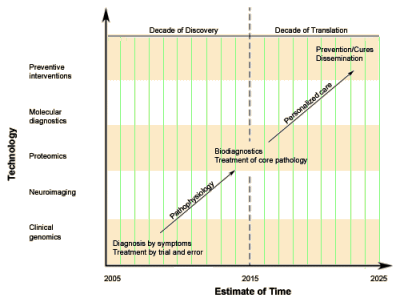In another week or so, I will have been director of NIMH for ten years. This is longer than any previous director dating back to the inaugural director, Bob Felix, who served from 1949 to1964. In leadership, longevity is not necessarily a virtue but it does guarantee perspective…
… But there is a more fundamental role for science, which is nothing less than the quest for understanding our world. The homeless man with schizophrenia, the non-verbal child with autism, and the soldier with PTSD need services and treatment, but also understanding — because the quest for understanding spawns compassion, intimacy, and even wonder. The past decade at NIMH has been all about this quest, recognizing that after six decades, we are still at the very beginning of understanding the world of mental illness. There really are no short-cuts.
But I believe we are on the right path, trying to solve mysteries from neurons to neighborhoods and the vast landscape in between, with tools that get better every year. Medicine recently has had spectacular successes: brilliant science has transformed how we can prevent or cure heart disease, AIDS, and now several forms of cancer. We are not there yet for any of the serious mental disorders that NIMH has pledged to prevent and cure. But make no mistake, these are mysteries with a solution. Genomics and neuroscience are revolutionizing the search with powerful new tools that will yield biomarkers, new diagnostics, and better treatments. It is when we hit a new level of understanding measured by patients, not papers, that there is truly a breakthrough. I know that “time matters.” I also know that science is not a sprint. But the marathon is not endless. At this ten-year mark, when I am breathless, it is not from the distance traveled or seeing the distance ahead, but from the challenge of keeping up with the progress around me…
 From the late 1980s, psychiatry’s preoccupation with the steady stream of psychiatric medications and their endless clinical trials sufficed as the fruits of evidence-based medicine – primarily the SSRIs and the atypical antipsychotics. Our journals filled with the regulation garb of medicine proper: graphs, tables, p values, etc. By the time Insel arrived at the NIMH in 2002, psychiatry was eager to hear his call to become "clinical neuroscience" and his 2005 schedule didn’t look nearly so grandiose as it does now.
From the late 1980s, psychiatry’s preoccupation with the steady stream of psychiatric medications and their endless clinical trials sufficed as the fruits of evidence-based medicine – primarily the SSRIs and the atypical antipsychotics. Our journals filled with the regulation garb of medicine proper: graphs, tables, p values, etc. By the time Insel arrived at the NIMH in 2002, psychiatry was eager to hear his call to become "clinical neuroscience" and his 2005 schedule didn’t look nearly so grandiose as it does now.

I seem to never tire of returning to this figure. This time I’m focused on the ordinate [y axis]. Notice it is Technology: genomics, neuroimaging, proteomics, molecular diagnosis, finally arriving at preventive interventions around 2020. It’s the same line as this recent blog, "Genomics and neuroscience are revolutionizing the search with powerful new tools that will yield biomarkers, new diagnostics, and better treatments". Success is up ahead, and the pathway to success is in the "tools that get better every year" – the technologies. His vision has been unswerving and is continuous with those who came before him. The new tools of neuroscience will reveal the biological substrate of mental illness after a "marathon" of research.
So Insel’s NIMH has been a directed research agency, jumping on the Translational Medicine ideas of the NIH – research focused on a speedy move to clinical application. And it was more focused than that. There were any number of programs that announced topics of interest. My fantasy is that instead of sitting under an apple tree waiting for an inspiring bump on the head, researchers spend their time surfing through the NIMH web-site looking for what’s getting funded this cycle. Besides directed research, there was much ado about partnering with industry. And waves of Clinical Drug Trials – STAR*D, CO-MED, CATIE, TADS, TORDIA, etc. Rather than a funding source for creative scientists, NIMH has been pointing the way. And Insel’s NIMH as been fad-driven. Something that fits comes along, and he’s talking about it in his next blog. Pretty soon, it’s a new direction, a new program. And Tom Insel has lived dangerously close to the pharmaceutical industry – thinking about fast tracking drugs, partnering, even taking over drug development to keep them in the game when they seem to pull away.
 Tom Insel wears a monocle that always sees the same thing – a future age of understanding of the neurobiological core of mental illness revealed through a series of new technologies responsive to biological interventions, and has relentlessly driven the NIMH towards that goal. He’s even spearheading the development of a new classification of mental phenomena based on the findings from these technologies – Research Domain Criteria [RDoC].
Tom Insel wears a monocle that always sees the same thing – a future age of understanding of the neurobiological core of mental illness revealed through a series of new technologies responsive to biological interventions, and has relentlessly driven the NIMH towards that goal. He’s even spearheading the development of a new classification of mental phenomena based on the findings from these technologies – Research Domain Criteria [RDoC].
Balancing Immediate Needs with Future Innovation
NIMH Director’s Blog
By Thomas Insel
January 26, 2012NIMH, like all Institutes at NIH, has an advisory council that meets three times each year. The National Advisory Mental Health Council (NAMHC) is a distinguished group of scientists, advocates, clinicians, and policy experts. Each of our meetings includes a closed session to review individual grants considered for funding and a session open to the public that engages this diverse group in discussions about the larger issues that guide NIMH funding.
At last week’s session, we heard a recurrent tension around one such larger issue. Some members of Council bear witness to the poor quality of care, the unmet medical need, and the diminishing investments by states on behalf of people with mental disorders. They reasonably ask, “How are we ensuring that the science that NIMH has produced is implemented where the need is greatest?” They also question on the pay-off of genetics research. After all, two decades after the gene for Huntington’s disease was identified, we still have no effective treatments, and Huntington’s disease is genetically far simpler than schizophrenia or bipolar disorder. In contrast to so many neurological diseases, we have effective treatments for schizophrenia and bipolar disorder. NIMH should be investing to ensure these are available.
The opposing argument runs something like this. There has been no major innovation in therapeutics for most mental disorders since 1960. Current treatments are not good enough for too many. Rather than investing scarce dollars for incremental improvements or increased dissemination of mediocre interventions, we need invest in the fundamental science of brain and behavior so that we can understand how to develop better treatments.
While I may have oversimplified the two sides of this debate, the divide is substantial. Some advisors want more funds in services research; other advisors want more funds in basic neuroscience. Some are thinking of the immediate needs; others are focused on the paradigm shifts that may be revealed by another decade of research. And with the NIMH budget stretched, tough choices must be made…
Sixty years ago, the nation faced a similar short-term vs. long-term debate about polio. The needs were growing and the causes were unknown. Some wanted funds invested only in better services, including improved iron lungs. Others argued for investing in a vaccine with a long-term goal of eradication. As David Oshinsky explains in his outstanding retelling of this debate, the government went with the services approach, leaving advocates and families to raise funds for vaccine development. Let us hope we don’t short-change our grandchildren, sixty years from today, by failing to invest in the long-term promise of more effective diagnostics and therapeutics for mental disorders.
 Tom Insel has created a National Institute of Clinical Neuroscience with a particular leaning towards psychopharmacological interventions. The focus is on the future discoveries that he feels are bound to come from his efforts. If there’s a model, it’s something like the Manhattan Project or DARPA, the great examples of research teams that created the Atomic Bomb, the Space Program, and the Internet – programs whose success needed a monocle to reach their goal, programs where they really did know where they were going and a lot about how to get there. What the National Institute of Mental Health is supposed to be is a funding agency that makes it possible for creative scientists with good ideas to explore them. That’s not what it is. It’s an agency with a one track mind, and that track is not perpetuated by huge successes. It’s sustained by the monocular view of Dr. Tom Insel and like-minded colleagues who have collectively been pointing us in the same direction for close to a generation without too much to show for it. I don’t personally feel so breathless, more in the range of tired and stuck. I find myself thinking we could use a pair of new glasses with two lenses looking at mental health research with less conviction that it has only one preordained direction and limited dimensions [AKA a rut]…
Tom Insel has created a National Institute of Clinical Neuroscience with a particular leaning towards psychopharmacological interventions. The focus is on the future discoveries that he feels are bound to come from his efforts. If there’s a model, it’s something like the Manhattan Project or DARPA, the great examples of research teams that created the Atomic Bomb, the Space Program, and the Internet – programs whose success needed a monocle to reach their goal, programs where they really did know where they were going and a lot about how to get there. What the National Institute of Mental Health is supposed to be is a funding agency that makes it possible for creative scientists with good ideas to explore them. That’s not what it is. It’s an agency with a one track mind, and that track is not perpetuated by huge successes. It’s sustained by the monocular view of Dr. Tom Insel and like-minded colleagues who have collectively been pointing us in the same direction for close to a generation without too much to show for it. I don’t personally feel so breathless, more in the range of tired and stuck. I find myself thinking we could use a pair of new glasses with two lenses looking at mental health research with less conviction that it has only one preordained direction and limited dimensions [AKA a rut]…
 r-sp
r-sp k
k t
t v]
v]noun
1. a. A view or vista.
b. A mental view or outlook: "It is useful occasionally to look at the past to gain a perspective on the present".
2. The appearance of objects in depth as perceived by normal binocular vision.
3. a. The relationship of aspects of a subject to each other and to a whole: a perspective of history; a need to view the problem in the proper perspective.
b. Subjective evaluation of relative significance; a point of view: the perspective of the displaced homemaker.
c. The ability to perceive things in their actual interrelations or comparative importance: tried to keep my perspective throughout the crisis.
4. The technique of representing three-dimensional objects and depth relationships on a two-dimensional surface.
Sorry, the comment form is closed at this time.